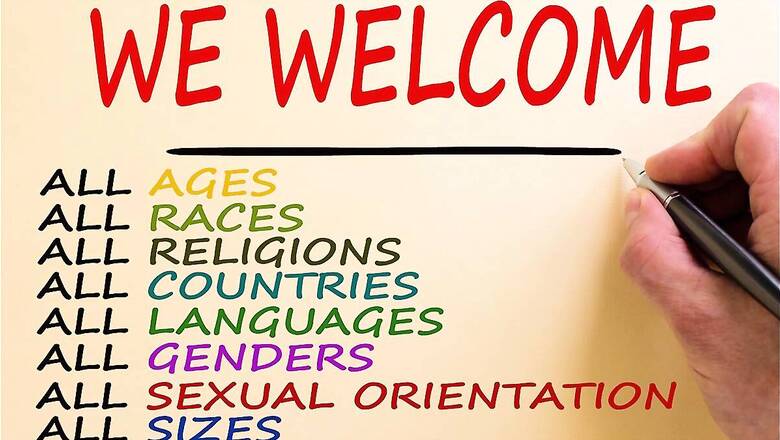
views
In the vibrant cultural mosaic that is India, unity in diversity is a cherished ideal. At the heart of this ideal is the recognition that every individual, regardless of gender identity or sexual orientation, has a role to play in the nation’s progress. As citizens, a crucial aspect of supporting diversity is to stand up for communities who are being marginalised, or just simply overlooked.
For the LGBTQ+ community, one of the pivotal areas where the community needs allies is in ensuring equal access to public amenities, particularly hygienic toilets. Because our existing toilets are set up according to a binary understanding of gender, transgender and non-binary persons are forced to choose between toilets earmarked for ‘males’ and ‘females’. A transgender person is someone who identifies with a gender different from the one assigned to them at birth. Non-binary persons, on the other hand, don’t strictly identify as male or female. Both transgender and third gender individuals often grapple with dysphoria—a disconnection between their body or societal perception and their true gender identity.
As most of our public spaces have no gender neutral toilets, we’re giving them no other choice than to use the ‘wrong’ toilet. Imagine the daily stress and anxiety faced by a transgender on non-binary person who has to constantly evaluate which public toilet to use, and then often faces ridicule or harassment, in addition to the ever present threat of physical confrontation. Forcing transgender and non-binary persons to use toilets that do not align with their gender identity can also exacerbate dysphoria, leading to profound emotional distress, depression, and anxiety.
Voices of Change: The Advocacy Landscape
Thankfully, there is a wave of change spreading across the nation. Activists, NGOs, members of the LGBTQ+ community themselves and even corporations have been working tirelessly to bring attention to this issue.
Legal Strides and Policy Reforms
The landmark judgement of the Supreme Court in 2014 recognized transgender people as a third gender, taking a monumental step forward towards inclusion. However, to make this recognition meaningful, activists are advocating for policies that ensure equal access to public amenities for all genders.
Moreover, there is a push for inclusive policies in the construction of public toilets, such as gender-neutral restrooms, which can go a long way in ensuring the safety and dignity of transgender and gender-nonconforming individuals.
Raising Awareness and Building Sensitization
Creating awareness about the struggles faced by LGBTQ+ individuals and sensitising the public and policymakers is an essential aspect of advocacy. Initiatives like Harpic and News18’s Mission Swachhta aur Paani transcends the concept of cleanliness alone. It is a movement that recognizes the profound significance of toilets, viewing them not merely as functional spaces but as beacons of safety and acceptance for the marginalised. This exceptional mission is built upon the firm belief that clean and inclusive toilets are vital for fostering a society that embraces and empowers us all, unconditionally. With unwavering dedication, Harpic and News18 actively include and advocate for the LGBTQ+ community, propelling the message that every individual deserves access to safe and accepting spaces, where their dignity is upheld, and their presence is celebrated.
By joining forces with Mission Swachhta aur Paani, advocacy groups can raise awareness about the particular challenges faced by the LGBTQ+ community as well as galvanise public support for inclusive sanitation policies.
Public-Private Partnerships
Government partnerships with corporations can be potent drivers of change. The Swachh Bharat Mission is a great example of this. The GoI joined hands with several organisations across various stages of the program. To name a few, Mahindra Group, Larsen & Toubro, IndusInd Bank, Tata Consultancy Services and Adani Group contributed to construction of toilets, or set funds aside for them.
Harpic, India’s leading brand in the lavatory care segment, has worked on several initiatives that are adjacent to the Swachh Bharat Mission – for instance, the establishment of Harpic World Toilet Colleges. Harpic has also taken the lead in designing campaigns and initiatives that not only focus on sanitation but also inclusivity.
What we need now is more participation – both from the GoI and the private sector. Corporate participation brings increased resources and reach, while GoI’s involvement throws the might of the government behind these initiatives. When combined, these create enormous multipliers that often bring surprisingly quick (and lasting) results.
Grassroots Movements
The fight for LGBTQ rights in India is largely led by grassroots movements and the current push for marriage equality is only the latest example. The fight to repeal Article 377 reads almost like an epic in itself, and is a testament to the staying power and effectiveness of grassroots movements in India.
It all began in earnest in 2001, when the Naz Foundation, an HIV advocacy group in Delhi, filed one of the first legal challenges to the colonial-era law. It took 17 years of advocacy and litigation, but in 2018, a more progressive bench revisited the issue. They heard challenges from more than two dozen people, including leading hoteliers, a prominent chef, an Indian classical dancer and many others. The court unanimously struck down the law and apologised for the delay in ensuring rights for LGBTQ+ people.
What we need now is a similar push – the more visibility we bring to the issue, the more acceptance it creates. As with the successful push to repeal Article 377, the movement built support from the ground up: conversations led to understanding, understanding led to acceptance, acceptance led to advocacy. It’s important to note that it wasn’t only the LGBTQ+ community who marched against Article 377, their cisgender allies did too.
That’s how lasting change is made – when we stand up for one another.
How can you be an effective ally?
Advocacy is not just the work of activists and NGOs; it is a collective responsibility that involves all of us. Advocacy comes in all shapes and stripes – it doesn’t need to involve protest marches, but it can, if that’s what you want to do. It doesn’t need to involve grand gestures of support either. Sometimes, the most important work we do is in the small, everyday conversations we have.
Start with educating yourself. Understand the issues faced by the LGBTQ+ community, particularly with regard to access to public toilets. Learn about the different gender identities and expressions, and the unique challenges faced by each. Harpic and News18’s Mission Swachhta aur Paani initiative has some great content you can dip into on its website.
Once you feel like you have a good enough grasp of the issues at hand, talk to people in your orbit. It is easier for people to accept a new idea when it comes from a friend, a family member or a colleague, than it is from reading an article somewhere. Each conversation you have, even unsuccessful ones, adds up. You’re moving the needle, one conversation at a time.
Another way to show support is to consider participating in advocacy efforts. Join campaigns, sign petitions, take part in meetings and demonstrations that focus on advocating for gender-inclusive public toilets. Next, support NGOs and grassroots organisations. Contribute in terms of money and/or time to these organisations – they always have a number of projects up in the air, and you never know where your expertise (or just your presence!) may be best used.
Work with the corporate sector. This is what CSR programs are made for! Encourage them to contribute to initiatives that focus on providing equal access to hygienic toilets for all. Even if you don’t succeed, you’ll have given them ideas on what they can do, in their own business. Imagine the ripple effect of every corporation making the switch from gendered to gender neutral toilets… and you’ll have played a part in making it happen. Of course, if you’re a business owner yourself, consider turning your own gendered toilets into gender neutral ones.
Engage with Local Government: Write letters, emails, or meet local representatives to communicate the importance of inclusive public sanitation facilities. Propose policy changes and suggest measures to make existing facilities more accessible – you know your locality best. Try and drum up support from your friends, or through your posts on social media, reach out to local celebrities and other people with a large following, and ask them to back your requests.
The Path Ahead: Making Equality a Reality
In sum, your contribution can be as big or as small as you can make it. Some of us will be able to march in protests, while some will be able to contribute monetarily, while still others will help build social media momentum. Some of us may have lives too busy to permit more than the signing of petitions. But we can all have conversations. We can all challenge perceptions and bust common myths. We can talk about how frightening gendered toilets can be, when we are forced to use the ‘wrong’ toilet – irrespective of our gender identity. It is only through persistent advocacy, policy reforms, public awareness campaigns, and collective action, we can build a more inclusive society.
As responsible citizens, it’s time to support this cause wholeheartedly. Let’s join hands with initiatives like Harpic and News18’s Mission Swachhta aur Paani, to pave the way for a future where hygienic toilets are accessible to all, irrespective of gender identity or sexual orientation. Our collective efforts can help in shaping an India where dignity, respect, and equality are the cornerstones of society. Let’s be the change we want to see.



















Comments
0 comment